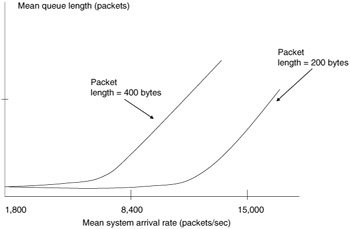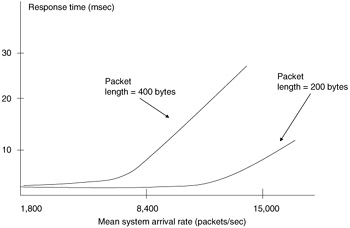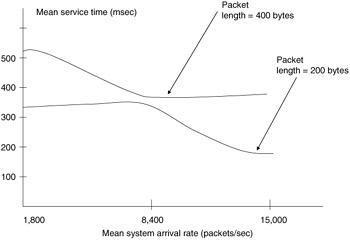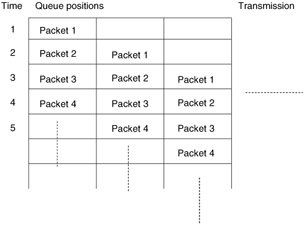10.2 Network performance tests
|
| < Free Open Study > |
|
10.2 Network performance tests
An analysis run is performed on the testbed by initializing all network hosts with a known arrival rate generator and then by using the generated message traffic to load the network while collecting the operational measures defined previously. After the run, the measures are combined and the desired performance measures are calculated.
The example test performed on the network testbed was formulated to give an indication of when, for a certain network configuration, the network becomes saturated (i.e., the network utilization approaches 1). For the example shown here, packet lengths of 200 and 400 bytes were tested with three nodes generating network traffic. The arrival rates at all three nodes were set up to be equal, and this rate varied from approximately 600 packets per second to approximately 15,000 packets per second. A test run was made for each of several arrival rates in the interval.
The mean queue length of packets awaiting transmission over the network for various arrival rates is shown in Figure 10.8. The values for each run using the measured values for T(i) and the queue lengths at each arrival time are found through a combination of equations (10.6), (10.7), and (10.9). Similarly, the mean response time was calculated using equations (10.5), (10.7), and (10.11) and is plotted in Figure 10.9.

Figure 10.8: Mean queue length.

Figure 10.9: Mean response time.
The utilization curve, shown in Figure 10.10, illustrates the percentage of the available data bandwidth that is being used to transmit message packets. From this graph, it can be seen that the particular network that we are analyzing approaches saturation (i.e., 100 percent utilization) rather quickly for the arrival rates and packet sizes shown.

Figure 10.10: Network utilization.
Figure 10.11 shows the effect of an increased arrival rate on service time. In this case, we have defined service time as the system busy time per completion, where the busy time considers the time a packet spends in the queue as well as the time it spends in transmission. When the system is saturated, however, there is always a packet ready to transmit, and so the queue fall-through time is hidden by this fact. Figure 10.12 illustrates this effect, which is known as pipelining.

Figure 10.11: Mean system service time.

Figure 10.12: Pipeline effect on queue fall-through time.
In Figure 10.13, the network throughput is plotted against the system arrival rate. The results show that after saturation, network throughput for this type of network remains constant. This is an important property for some systems, especially since some network protocols cause degraded throughput under increased system load.

Figure 10.13: Network throughput.
The final graph, shown in Figure 10.14, shows the time for a message to propagate through the network. This time does not include the queue wait time. When the system is lightly loaded, this time will include the time for the token to travel around the network. Under heavy load, the time includes the delay associated with transmissions of message packets at other nodes.

Figure 10.14: Network service time.
This example has served a dual purpose: to illustrate the usefulness of hardware modeling in certain cases and to show the application of some of the operational analysis techniques discussed in Chapter 7. For hardware modeling, assumptions about the network behavior can be validated. Operational analysis enables us to calculate quantities of interest that either are not directly measurable or that are too difficult to measure without disturbing the actual operation of the network itself.
|
| < Free Open Study > |
|
EAN: 2147483647
Pages: 136
- Chapter III Two Models of Online Patronage: Why Do Consumers Shop on the Internet?
- Chapter VIII Personalization Systems and Their Deployment as Web Site Interface Design Decisions
- Chapter XIII Shopping Agent Web Sites: A Comparative Shopping Environment
- Chapter XV Customer Trust in Online Commerce
- Chapter XVI Turning Web Surfers into Loyal Customers: Cognitive Lock-In Through Interface Design and Web Site Usability